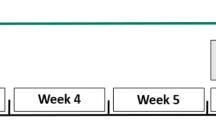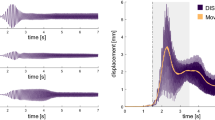Abstract
Objective:
To evaluate the effects of whole-body vibration on fat, bone, leptin and muscle mass.
Methods/Design:
Thirty 7-month-old female 344 Fischer rats were randomized by weight into three groups (baseline, vibration or control; n=8–10 per group). Rats in the vibration group were placed inside individual compartments attached to a Pneu-Vibe vibration platform (Pneumex, Sandpoint, ID, USA) and vibrated at 30–50 Hz (6 mm peak to peak) for 30 min per day, 5 days per week, for 12 weeks. The vibration intervention consisted of six 5-min cycles with a 1-min break between cycles.
Results:
There were significant body composition differences between the whole-body vibration and the control group. The whole-body vibration group weighed approximately 10% less (mean±s.d.; 207±10 vs 222±15 g, P<0.03) and had less body fat (20.8±3.8 vs 26.8±5.9 g, P<0.05), a lower percentage of body fat (10.2±1.7 vs 12±2.0%, P<0.05), and lower serum leptin levels (1.06±0.45 vs 2.27±0.57 ng ml−1, P<0.01) than the age-matched controls. No differences were observed for total lean mass, bone mineral content (BMC), bone mineral density (BMD), insulin-like growth factor-I (IGF-I) or soleus (SOL) and extensor digitorum longus (EDL) mass or function. Regional high-resolution dual-energy X-ray absoptiometry scans of the lumbar spine (L1-4) revealed that the whole-body vibration group had significantly greater BMC (0.33±0.05 vs 0.26±0.03 g, P<0.01) and BMD (0.21±0.01 vs 0.19±0.01 g cm−2, P<0.01) than the control group. No differences between the groups were observed in the amount of food consumed.
Conclusion:
These findings show that whole-body vibration reduced body fat accumulation and serum leptin without affecting whole body BMC, BMD or lean mass. However, the increase in vertebral BMC and BMD suggests that vibration may have resulted in local increases in bone mass and density. Also, whole-body vibration did not affect muscle function or food consumption.
This is a preview of subscription content, access via your institution
Access options
Subscribe to this journal
Receive 12 print issues and online access
$259.00 per year
only $21.58 per issue
Buy this article
- Purchase on Springer Link
- Instant access to full article PDF
Prices may be subject to local taxes which are calculated during checkout


Similar content being viewed by others
References
Ogden CL, Carroll MD, Curtin LR, McDowell MA, Tabak CJ, Flegal KM . Prevalence of overweight and obesity in the United States, 1999–2004. J Am Med Assoc 2006; 295: 1549–1555.
National Center for Health Statistics. Centers for Disease Control and Prevention Web site. National Health and Nutrition Examination Survey Data. http://www.cdc.gov/nchs/nhanes.htm. October 17, 2007. Accessed October 17, 2007.
Flegal KM, Graubard BI, Williamson DF, Gail MH . Excess deaths associated with underweight, overweight, and obesity. J Am Med Assoc 2005; 293: 1861–1867.
Slyper AH . The pediatric obesity epidemic: causes and controversies. J Clin Endocrinol Metab 2004; 89: 2540–2547.
Stein CJ, Colditz GA . The epidemic of obesity. J Clin Endocrinol Metab 2004; 89: 2522–2525.
American Dietetic Association (ADA). Position of the American Dietetic Association: individual-, family-, school-, and community-based interventions for pediatric overweight. J Am Diet Assoc 2006; 106: 925–945.
Stice E, Shaw H, Marti CN . A meta-analytic review of obesity prevention programs for children and adolescents: the skinny on interventions that work. Psychol Bull 2006; 132: 667–691.
Styne DM . A plea for prevention. Am J Clin Nutr 2003; 78: 199–200.
Jakicic JM, Otto AD . Physical activity considerations for the treatment and prevention of obesity. Am J Clin Nutr 2005; 82 (1 Suppl): 226S–229S.
Catenacci VA, Wyatt HR . The role of physical activity in producing and maintaining weight loss. Nat Clin Pract Endocrinol Metab 2007; 3: 518–529.
Rittweger J, Ehrig J, Just K, Mutschelknauss M, Kirsch KA, Felsenberg D . Oxygen uptake in whole-body vibration exercise: influence of vibration frequency, amplitude, and external load. Int J Sports Med 2002; 23: 428–432.
Rittweger J, Schiessl H, Felsenberg D . Oxygen uptake during whole-body vibration exercise: comparison with squatting as a slow voluntary movement. Eur J Appl Physiol 2001; 86: 169–173.
Rubin CT, Capilla E, Luu YK, Busa B, Crawford H, Nolan DJ et al. Adipogenesis is inhibited by brief, daily exposure to high-frequency, extremely low-magnitude mechanical signals. Proc Natl Acad Sci USA 2007; 104: 17879–17884.
Shapses SA, Riedt CS . Bone, body weight, and weight reduction: what are the concerns? J Nutr 2006; 136: 1453–1456.
Cummings SR, Black DM, Nevitt MC, Browner W, Cauley J, Ensrud K et al. Bone density at various sites for prediction of hip fractures. The Study of Osteoporotic Fractures Research Group. Lancet 1993; 341: 72–75.
Pouilles JM, Tremollieres F, Saint-Martin F, Ribot C . [Postmenopausal bone loss: results of a topographic study by X-ray absorptiometry]. Rev Rhum Ed Fr 1993; 60: 891–896.
Flieger J, Karachalios T, Khaldi L, Raptou P, Lyritis G . Mechanical stimulation in the form of vibration prevents postmenopausal bone loss in ovariectomized rats. Calcif Tissue Int 1998; 63: 510–514.
Fritton JC, Rubin CT, Qin YX, McLeod KJ . Whole-body vibration in the skeleton: development of a resonance-based testing device. Ann Biomed Eng 1997; 25: 831–839.
Rubin C, Pope M, Fritton JC, Magnusson M, Hansson T, McLeod K . Transmissibility of 15-hertz to 35-hertz vibrations to the human hip and lumbar spine: determining the physiologic feasibility of delivering low-level anabolic mechanical stimuli to skeletal regions at greatest risk of fracture because of osteoporosis. Spine 2003; 28: 2621–2627.
Rubin C, Xu G, Judex S . The anabolic activity of bone tissue, suppressed by disuse, is normalized by brief exposure to extremely low-magnitude mechanical stimuli. FASEB J 2001; 15: 2225–2229.
Rubin CT, Lanyon LE . Regulation of bone formation by applied dynamic loads. J Bone Joint Surg Am 1984; 66: 397–402.
Rubin CT, McLeod KJ . Promotion of bony ingrowth by frequency-specific, low-amplitude mechanical strain. Clin Orthop Relat Res 1994; 298: 165–174.
Rubin C, Recker R, Cullen D, Ryaby J, McCabe J, McLeod K . Prevention of postmenopausal bone loss by a low-magnitude, high-frequency mechanical stimuli: a clinical trial assessing compliance, efficacy, and safety. J Bone Miner Res 2004; 19: 343–351.
Verschueren SM, Roelants M, Delecluse C, Swinnen S, Vanderschueren D, Boonen S . Effect of 6-month whole body vibration training on hip density, muscle strength, and postural control in postmenopausal women: a randomized controlled pilot study. J Bone Miner Res 2004; 19: 352–359.
Roelants M, Delecluse C, Verschueren SM . Whole-body-vibration training increases knee-extension strength and speed of movement in older women. J Am Geriatr Soc 2004; 52: 901–908.
LaMothe JM, Zernicke RF . Rest insertion combined with high-frequency loading enhances osteogenesis. J Appl Physiol 2004; 96: 1788–1793.
Widrick JJ, Fuchs R, Maddalozzo GF, Marley K, Snow C . Relative effects of exercise training and alendronate treatment on skeletal muscle function of ovariectomized rats. Menopause 2007; 14 (3 Pt 1): 528–534.
Thomsen JS, Laib A, Koller B, Prohaska S, Mosekilde L, Gowin W . Stereological measures of trabecular bone structure: comparison of 3D micro computed tomography with 2D histological sections in human proximal tibial bone biopsies. J Microsc 2005; 218 (Pt 2): 171–179.
Dedeoglu EN, Erenus M, Yoruk P . Effects of hormone therapy and tibolone on body composition and serum leptin levels in postmenopausal women. Fertil Steril 2008 (in press).
Scholze A, Tepel M . Role of leptin in reverse epidemiology in chronic kidney disease. Semin Dial 2007; 20: 534–538.
Vona-Davis L, Howard-McNatt M, Rose DP . Adiposity, type 2 diabetes and the metabolic syndrome in breast cancer. Obes Rev 2007; 8: 395–408.
Gilsanz V, Wren TA, Sanchez M, Dorey F, Judex S, Rubin C . Low-level, high-frequency mechanical signals enhance musculoskeletal development of young women with low BMD. J Bone Miner Res 2006; 21: 1464–1474.
Gusi N, Raimundo A, Leal A . Low-frequency vibratory exercise reduces the risk of bone fracture more than walking: a randomized controlled trial. BMC Musculoskelet Disord 2006; 7: 92.
Ward K, Alsop C, Caulton J, Rubin C, Adams J, Mughal Z . Low magnitude mechanical loading is osteogenic in children with disabling conditions. J Bone Miner Res 2004; 19: 360–369.
Zarrabeitia MT, Hernandez JL, Valero C, Zarrabeitia A, Amado JA, Gonzalez-Macias J et al. Adiposity, estradiol, and genetic variants of steroid-metabolizing enzymes as determinants of bone mineral density. Eur J Endocrinol 2007; 156: 117–122.
Ballor DL, Poehlman ET . Exercise-training enhances fat-free mass preservation during diet-induced weight loss: a meta-analytical finding. Int J Obes Relat Metab Disord 1994; 18: 35–40.
Bosco C, Iacovelli M, Tsarpela O, Cardinale M, Bonifazi M, Tihanyi J et al. Hormonal responses to whole-body vibration in men. Eur J Appl Physiol 2000; 81: 449–454.
Kvorning T, Bagger M, Caserotti P, Madsen K . Effects of vibration and resistance training on neuromuscular and hormonal measures. Eur J Appl Physiol 2006; 96: 615–625.
Juul A, Bang P, Hertel NT, Main K, Dalgaard P, Jørgensen K et al. Serum insulin-like growth factor-I in 1030 healthy children, adolescents, and adults: relation to age, sex, stage of puberty, testicular size, and body mass index. J Clin Endocrinol Metab 1994; 78: 744–752.
Author information
Authors and Affiliations
Corresponding author
Rights and permissions
About this article
Cite this article
Maddalozzo, G., Iwaniec, U., Turner, R. et al. Whole-body vibration slows the acquisition of fat in mature female rats. Int J Obes 32, 1348–1354 (2008). https://doi.org/10.1038/ijo.2008.111
Received:
Revised:
Accepted:
Published:
Issue Date:
DOI: https://doi.org/10.1038/ijo.2008.111
Keywords
This article is cited by
-
Combating osteoporosis and obesity with exercise: leveraging cell mechanosensitivity
Nature Reviews Endocrinology (2019)
-
The effect of multi-frequency whole-body vibration on night-shifted mouse model
Sleep and Biological Rhythms (2018)
-
Multiscale investigation on the effects of additional weight bearing in combination with low-magnitude high-frequency vibration on bone quality of growing female rats
Journal of Bone and Mineral Metabolism (2018)
-
Potential regenerative rehabilitation technology: implications of mechanical stimuli to tissue health
BMC Research Notes (2014)
-
Impact des ultrasons diffus combinés au travail musculaire sur plaque vibrante sur la modification de la composition corporelle de femmes modérément obèses
Obésité (2014)



